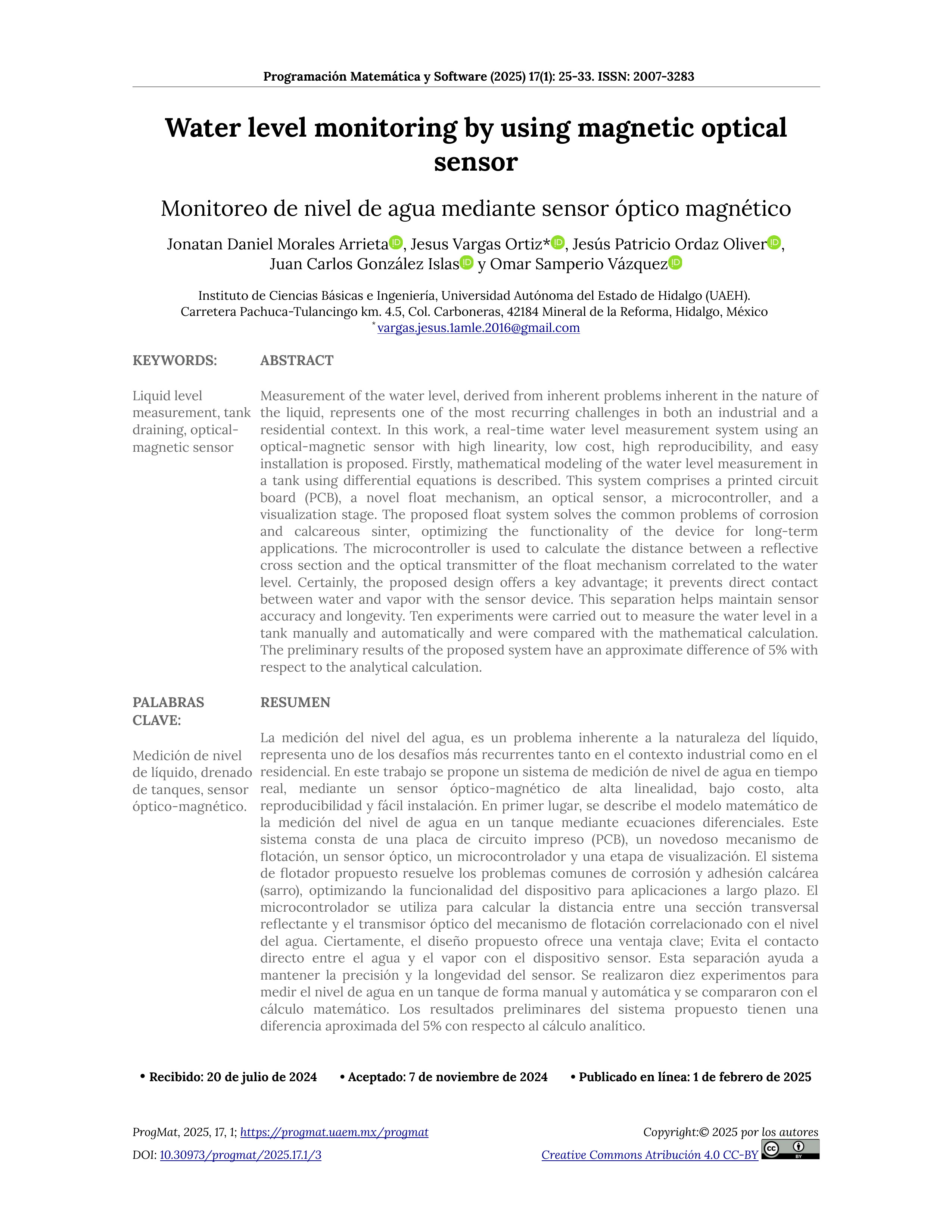Monitoreo de nivel de agua mediante sensor óptico magnético
DOI:
https://doi.org/10.30973/progmat/2025.17.1/3Palabras clave:
Medición de nivel de líquido, drenado de tanques, sensor óptico-magnéticoResumen
La medición del nivel del agua, es un problema inherente a la naturaleza del líquido, representa uno de los desafíos más recurrentes tanto en el contexto industrial como en el residencial. En este trabajo se propone un sistema de medición de nivel de agua en tiempo real, mediante un sensor óptico-magnético de alta linealidad, bajo costo, alta reproducibilidad y fácil instalación. En primer lugar, se describe el modelo matemático de la medición del nivel de agua en un tanque mediante ecuaciones diferenciales. Este sistema consta de una placa de circuito impreso (PCB), un novedoso mecanismo de flotación, un sensor óptico, un microcontrolador y una etapa de visualización. El sistema de flotador propuesto resuelve los problemas comunes de corrosión y adhesión calcárea (sarro), optimizando la funcionalidad del dispositivo para aplicaciones a largo plazo. El microcontrolador se utiliza para calcular la distancia entre una sección transversal reflectante y el transmisor óptico del mecanismo de flotación correlacionado con el nivel del agua. Ciertamente, el diseño propuesto ofrece una ventaja clave; Evita el contacto directo entre el agua y el vapor con el dispositivo sensor. Esta separación ayuda a mantener la precisión y la longevidad del sensor. Se realizaron diez experimentos para medir el nivel de agua en un tanque de forma manual y automática y se compararon con el cálculo matemático. Los resultados preliminares del sistema propuesto tienen una diferencia aproximada del 5% con respecto al cálculo analítico.
Citas
Gilmore TE, Birgand F, Chapman KW. Source and magnitude of error in an inexpensive image-based water level measurement system. Journal of Hydrology. 2013;496:178-186. https://doi.org/10.1016/j.jhydrol.2013.05.011.
Mohindru P. Development of liquid level measurement technology: A review. Flow Measurement and Instrumentation. 2023;89:102295. https://doi.org/10.1016/j.flowmeasinst.2022.102295.
Chetpattananondh K, Tapoanoi T, Phukpattaranont P, Jindapetch N. A self-calibration water level measurement using an interdigital capacitive sensor. Sensors and Actuators A: Physical. 2014;209:175-182. https://doi.org/10.1016/j.sna.2014.01.040.
Creus SA. Instrumentación Industrial. Barcelona, España: Marcombo; 2005..
Nikolov G, Nikolova B. Virtual techniques for liquid level monitoring using differential pressure sensors. Recent. 2008;9(2):49.
Vass G. The principles of level measurement: RF capacitance, conductance, hydrostatic tank gauging, radar, and ultrasonics are the leading sensor technologies in liquid level tank measurement and control. Sensors - The Journal of Applied Sensing Technology. 2000;17(10):55-64.
Wang T-H, Lu M-C, Hsu C-C, Chen C-C, Tan J-D. Liquid-level measurement using a single digital camera. Measurement. 2009;42(4):604-610. https://doi.org/10.1016/j.measurement.2008.10.006.
Zhang Z, Zhou Y, Liu H, Zhang L, Wang H. Visual measurement of water level under complex illumination conditions. Sensors. 2019;19(19):4141. https://doi.org/10.3390/s19194141.
Thomsen A, Hansen B, Schelde K. Application of TDR to water level measurement. Journal of Hydrology. 2000;236(3-4):252-258. https://doi.org/10.1016/S0022-1694(00)00305-X.
Jing N, Teng C, Zheng J, Wang G, Chen Y, Wang Z. A liquid level sensor based on a race-track helical plastic optical fiber. IEEE Photonics Technology Letters. 2016;28(2):158-160. https://doi.org/10.1109/LPT.2016.2630730.
Dini DC, Penze RS, Rosolem JB, Floridia C, Leonardi AA. Fiber optic bending sensor for water level monitoring: Development and field test: A review. IEEE Sensors Journal. 2013;13(11):4113-4120. https://doi.org/10.1109/JSEN.2013.2278074.
Qurthobi A, Iskandar RF, Krisnatal A, Weldzikarvina. Design of capacitive sensor for water level measurement. Journal of Physics: Conference Series. 2016;776(1):012118. https://doi.org/10.1088/1742-6596/776/1/012118.
Zill DG, El-Iraki A, García Hernández AE, Fillo López E. Ecuaciones diferenciales con aplicaciones de modelado. 11a ed. Cuajimalpa, Ciudad de México: Cengage Learning; 2018.
Graham C, Cullity B. Introduction to Magnetic Materials. Hoboken, New Jersey: John Wiley & Sons, Inc.; 2009. https://doi.org/10.1002/9780470386323.
Santiago Espinosa F. El Microcontrolador ATMega328P de Microchip: Programación en Ensamblador, Lenguaje C y un enlace con Arduino. Huajuapan de León: Universidad Tecnológica de la Mixteca; 2021. [Consultado el 10 de junio de 2024]. Disponible en: http://repositorio.utm.mx:8080/handle/123456789/388?mode=full.
STMicroelectronics. Time-of-flight ranging sensor VL53L0X. ST Life. Augmented; 2024. [Consultado el 21 de junio de 2024]. Disponible en: https://www.st.com/en/imaging-and-photonics-solutions/vl53l0x.html.
Leontitsis A. Cronbach's Alpha. Matlab Central File Exchange; 2024. [Consultado el 18 de junio de 2024]. Disponible en: https://la.mathworks.com/matlabcentral/fileexchange/7829-cronbach-s-alpha.

Descargas
Publicado
Cómo citar
Número
Sección
Licencia
Derechos de autor 2025 Jonatan Daniel Morales Arrieta, Jesus Vargas Ortiz, Jesús Patricio Ordaz Oliver, Juan Carlos González Islas, Omar Samperio Vázquez

Esta obra está bajo una licencia internacional Creative Commons Atribución 4.0.
Usted es libre de:
 |
Compartir — compartir y redistribuir el material publicado en cualquier medio o formato. |
 |
Adaptar — combinar, transformar y construir sobre el material para cualquier propósito, incluso comercialmente. |
Bajo las siguientes condiciones:
 |
Atribución — Debe otorgar el crédito correspondiente, proporcionar un enlace a la licencia e indicar si se realizaron cambios. Puede hacerlo de cualquier manera razonable, pero de ninguna manera que sugiera que el licenciador lo respalda a usted o a su uso. |
| Sin restricciones adicionales: no puede aplicar términos legales o medidas tecnológicas que restrinjan legalmente a otros a hacer cualquier cosa que permita la licencia. |









